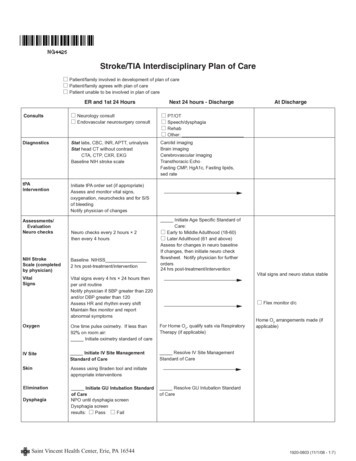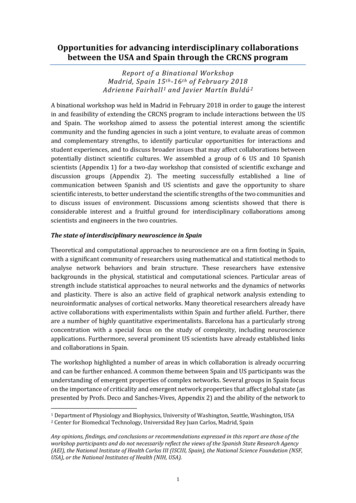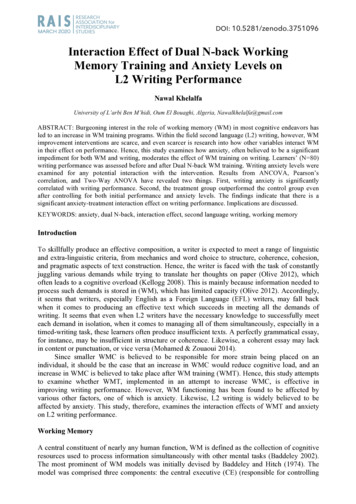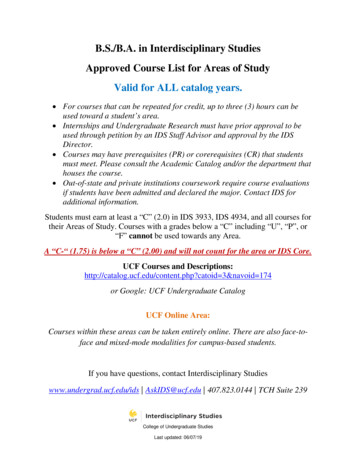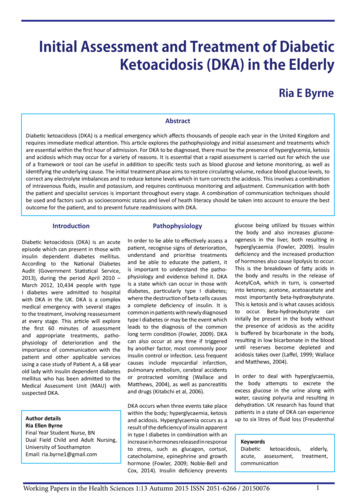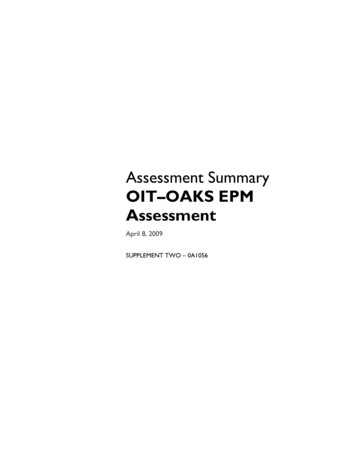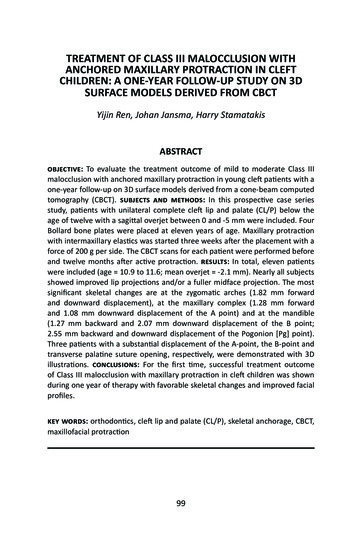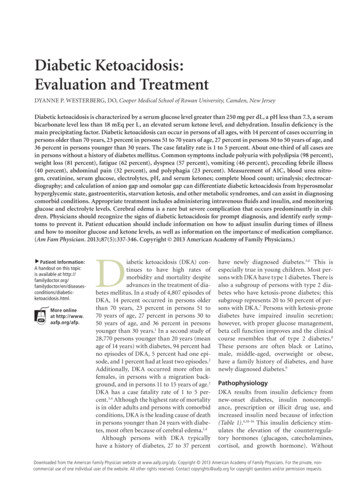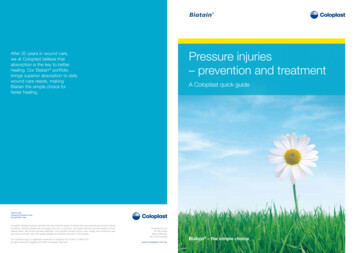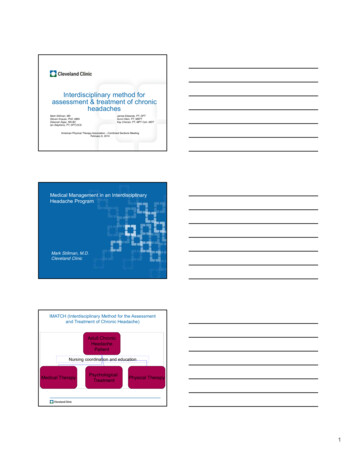
Transcription
Interdisciplinary method forassessment & treatment of chronicheadachesMark Stillman, MDSteven Krause, PhD, MBADeborah Zajac, RN-BCIan Stephens, PT, DPT,OCSJames Edwards, PT, DPTSunni Klein, PT, MSPTKay Cherian, PT, MPT Cert. MDTAmerican Physical Therapy Association – Combined Sections MeetingFebruary 6, 2014Medical Management in an InterdisciplinaryHeadache ProgramMark Stillman, M.D.Cleveland ClinicIMATCH (Interdisciplinary Method for the Assessmentand Treatment of Chronic Headache)Adult ChronicHeadachePatientNursing coordination and educationMedical TherapyPsychologicalTreatmentPhysical Therapy1
Role of Medical Management in Headache Practice Diagnosis of headache based on history and physicalexamination– History based on ICHD classification and determineschronic from episodic– Physical examination distinguishes primary headaches (exam, normal) from secondary headaches:– Structural lesion of the brain– Structural lesion of craniocervical junction and c-spine– Raised ICP (Idiopathic intracranial HTN)Role of Medical Management in Headache Practice Manages medical conditions and reviews w/u– Initiates detoxification regimen– Infused bridge therapy and abortive therapy– Procedures (LP, blocks) Refers to consultants (e.g. sleep, EMG, neuroradiology) Communicates with PT, Psych and Nursing– Interdisciplinary team meeting and ad libInternational Headache Society Diagnostic Criteria for(1.1) Migraine (2013)C. Headache has at least 2 of theD. During headache at least oneof the following: Unilateral location Pulsating quality Aggravation by or causing Nausea and/or vomitingfollowing:avoidance from routine physicalactivity Moderate or severe pain Photophobia and phonophobiaE. Not attributed to anotherdisorderintensity2
Cervicogenic Headaches (ICHD-II,2004; ICHD-IIIbeta,2013)A. Pain, referred from a source in the neck andperceived in one or more regions of the headand/or face, fulfilling criteria C and D.B. Clinical, laboratory, and/or imaging evidence of adisorder or lesion within the cervical spine or softtissues of the neck known to be, or generallyaccepted as, a valid cause of headache.Cervicogenic Headaches (ICHD-II,2004; ICHD-IIIbeta, 2013)C. Evidence that the pain can be attributed to the neckdisorder or lesion based on at least one of the following:1. Demonstration of clinical signs that implicate a sourceof pain in the neck.2. Abolition of headache following diagnostic blockade ofa cervical structure or its nerve supply using placeboor other adequate control.D. Pain resolves within 3 months after successful treatmentof the causative disorder or lesionCervicogenic Headaches (ICHD-II,2004;ICHD-III beta, 2013) Tumors, fractures, infections, and rheumatoid arthritis of the uppercervical spine have not been validated as causes of headache, yetthey are accepted. Cervical spondylosis and osteochondritis are not accepted as valid. When myofascial tender points are the cause, the headache shouldbe coded under tension-type headaches3
Cervicogenic HeadachesEdmeads (1988) - In order for cervicogenic headaches to exist, theremust be:1. Pain sensitive structures in the neck2. Identifiable pathological process or dysfunction3. Pathways by which pain in the cervical segments arereferred to the head.Neurology 1988 Dec;38(12):1874-8Pain Sensitive Structures in the Neck Vertebral Column Apophyseal joints– Atlanto-occipital (condylar) joints– Annulus fibrosis– Spinal ligaments– Vertebral periosteum and marrow Cervical muscles, roots and nerves Vertebral and carotid arteriesComparison of Migraine and Cervicogenic HeadacheFeatureMigraineCerv. HARecurrent syesPhoto/phonophobiayesyesPulsating qualityyesyesMod-severe intensityyesyes4
Fredriksen, Hovdal, Sjaastad (1987)Signs of neck involvement (11/11) Ipsilateral, diffuse neck/shoulder, or arm pain (10/11), and/or Provocation of attacks by neck movement. Myofascial trigger points found in 10/11 patients. Pfaffenrath: Failure to respond to indomethacin (additionalfeature).Cephalalgia 1987 Jun;7(2):147-60Davidoff (1998): Myofascial Pain in Relation toHeadaches Myofascial pain syndromes characterized by the presence oftrigger points (TrP) that refer pain to distant sites.– Active TrP spontaneously causes complaints of pain– Latent TrP are palpable but do not cause spontaneouspain.– Palpation of TrP refers pain to distant sitesCephalalgia 1998 Sep;18(7):436-48Davidoff (1998): Myofascial Pain in Relation toHeadaches Distinguished myofascial pain syndromes from fibromyalgia, whichhe considered a systemic disease. FM: characterized by tender points and not trigger points:– No jump sign, palpable band, ‘twitch sign’, or relief of pain whensite is anesthetizedCephalalgia 1998 Sep;18(7):436-485
Davidoff (1998): Myofascial Pain in Relation toHeadaches Cervicogenic headaches can be differentiated from migraines andTTH by local anesthetic blockade of C2 root, greater occipital nerve,and structures innervated by them (e.g. TrPoints). Trigger points innervated by lower cervical nerves do not directlycause headaches.Cephalalgia 1998 Sep;18(7):436-48Diagnostic Criteria for Tension-Type Headache (ICHD-II,2004) At least 10 previous headacheepisodes fulfilling criteria B-Dlisted below. Number of days with suchheadache 180/year ( 15/month).A. Headache lasting from 30 minutesto 7 daysB. At least 2 of the following paincharacteristics:– Pressing/tightening (nonpulsating) quality– Mild or moderate intensity(may inhibit, but does notprohibit activities)– Bilateral location– No aggravation by walkingstairs or similar routine activityDiagnostic Criteria for Tension-Type Headache (ICHD-II,2004)C. Bothof the following: No nausea or vomitingD. At least one of the following: History, physical and(anorexia may occur) Photophobia and phonophobiaare absent, or one but not theother is present neurological examinations donot suggest one of thedisorders in groups 5-11History and/or physical- and/orneurological examinations dosuggest such disorder, but it isruled out by appropriateinvestigationsSuch disorder is present, buttension-type headache doesnot occur for the first time inclose temporal relation to thedisorder6
The environment of dinationProgram overviewSteven J. Krause, Ph.D., M.B.A.Cleveland ClinicChronic Daily Headache (CDH) - Epidemiology Chronic Daily Headache – 15 headaches per month 3.5% to 4% of population suffers from CDH Headaches account for 7.9% of all medical visits, and 9.7%of all emergency visits.Bigal et al. (2008); DeFilippis et al. (2006); Stovner et al. (2006); Wiendals et al.(2006)7
Chronic Daily Headache (CDH) - Epidemiology 12% of CDH cases resolve to intermittent headaches within5 months. Both CDH and intermittent headache patients more likely tobe female than non-headache primary care patients. Chronic Headaches are associated with lower SES, and amore frequent history of head & neck trauma.Bigal et al., 2008; Wiendals et al., 2006Chronic Daily Headache (CDH) - Comorbidities Compared to patients with intermittent headaches, CHDpatients:– More likely to overuse medication (67% vs. 3%)– More frequent sleep problems (44% vs. 8%)– More likely to smoke (45% vs. 19%)AMPP – American migraine prevalence & preventionstudy(Buse, et. al., 2010)cs8
Depression & migraine(Zwart et.al., 2003)Depression & migraine Diagnosis– Cognitive Aspects– Affective Aspects– Somatic Aspects Common neurotransmittersubstrate with painAnxiety & migraine(Zwart et.al., 2003)9
Anxiety & migraine Fears of movement– Inactivity and rumination Pre-morbid anxietydisordersJette, et al (2008)Physical Consequences of CDH Overuse of rest as a coping strategy “Roller coaster” activityDate1234567Avg.Pain rating Pain ratingUptime1234567Physical Consequences of CDH Myofascial PainSyndromes Reduced EndorphinProduction Disuse Atrophy Increased Risk of Injury10
Multidisciplinary Treatment of Chronic Daily Headache Medical therapy– Detoxification from rebound producing medication– Establishment of headache preventatives– Treatment of co-morbid depression and anxietyMultidisciplinary Treatment of Chronic Daily Headache Physical therapy– Active vs. passivetreatment– Strengthening andrange of motion– Aerobic conditioningMultidisciplinary Treatment of Chronic Daily Headache Psychological therapy– Pain behavior management– Family Education– Assertiveness training– Cognitive-behavioral psychotherapy– Sleep hygiene– Activity pacing– Relaxation and biofeedback– Self-esteem11
Multidisciplinary Treatment of Chronic Daily Headache Nursing therapy– Pathophysiology of headaches– Dietary management– Mindfulness– Medical communications– Appropriate medication use– Headaches & intimacy– Autogenic relaxation– Discharge planningIMATCH ProgramNursing’s Role and EducationDeborah C. Zajac RN, BSN-BCCleveland ClinicWhat do we really do?We lead them in, show them the way and them let themgo!We are the true boarder collies of the team and the gluethat keeps everything running smoothly.12
Yep!! That’s us the big bad dog.Insurance verificationMedical communicationsConciergeDischarge ication use/adherenceTough love advocateOutcomes reviewTrouble shooterSales personCrisis drillsCoordination of careNursing education occursbefore, during and afterthe program.13
Before the program Sales person and program “pitch” person / Program Concierge̵̵̵̵̵Medical records retriever & reviewer.Resource person for out of state referrals.Insurance verification and authorization.Scheduler.Enrollment & admissions process and orientation into the program.During the program Coordination of care, including management betweenIMATCH disciplines and ancillary departments. Education.Shoulder to cry on.Tough love advocate.Trouble shooter.Mindfulness supporter.Crisis drill sergeant.Discharge planner.Nursing staff provide: Diagnosis overview twist on old informationSymptoms retraining or breaking bad habitsMedication (reinforce use and limitations)Diary (focus changes to emphasis on functionalmanagement) Sleep Management (review and reinforce) Activity/Exercise (focus on daily activity andreinforce benefits)American Physical Therapy Association 201414
Nursing staff provide: cont. Diet (de-emphasis trigger response, reinforcemaintenance and hydration) Triggers (de-emphasis ) Crisis Plan (review compliance of plan,acknowledge positive accomplishments) Behavioral Support ( maintain rapport) Adherence (follow-up)American Physical Therapy Association 2014Diagnosis Overview1.Reinforce the diagnosis and the outcome of treatment byreviewing the theories behind headaches, e.g. vascular, serotoninand neural (In simple terms).2.Emphasize that education is geared towards “management” notcure of their headaches.Symptom ManagementThis is all about retraining andbreaking bad habits!!!!1. Stop the cycle of overuse, under use, and misuse thatlikely contributed to their headache chronicity.2. Review of current symptom management and lifestylepractices.15
Medication EducationThe focus changes to “less is best”.1.Review their knowledge of current medications including purpose,dose, side effects and “off label” uses for headache management.2.Continue to enforce the use of a diary to record use of abortivemedication. This is essential if the patient has a history ofrebound, or if there are multiple abortive medications prescribed.3.Reinforce the importance of one drug for moderate and one drugfor severe levels of pain and that treatment days are limited to 2days per week.Diary EducationReinforcement of functional management isemphasized.The diary helps keep patients on track with the thingsthey can do to manage their headaches outside ofmedication.1. Sleep2. Food intake3. Hydration4. Exercise5. Record of menstrual cycle (females)Sleep Education1. Reinforce the importance of regular sleep hours.2. Avoid using the bed for any activities exceptsleep.3. Avoid stimulants before bedtime.4. Set routine habits before bedtime to help your5.body and mind transition into knowing it is timefor sleep.The hours you keep are just as important as thehours you sleep.- Same time to bed, same time out of bed- No naps!!16
Activity & Exercise Education1. Review the type, frequency, quality and duration ofthe activity the patient has been doing along with anybenefit obtained.2. “Are they really doing what they say they are doing”?3. Many patients will state “they are exercising” butwhen narrowed down, the actual activities may beless than adequate.4. Make sure they journal actual date, time and activitycompleted. If there are holes in their story ask them tobring journal to next appointment. Hold themaccountable!!!!ENCOURAGE, ENCOURAGE, ENCOURAGEDiet Education1. Emphasis should be placed on using dietmanagement as part of headache prevention. aswell as contributing to an overall healthier body.2. Hydration, hydration, hydration . Record ounces ofwater taken in daily to ensure adequate hydration(the goal is 64 ounces per day).3. Review diary to ensure they are eating at least threemeals per day, since dietary gaps could lead toheadache episodes.4. Review caffeine intake.Trigger Education1. De-emphasize trigger avoidance since this promotesanxiety, stress and decrease function.2. Stress is the most common trigger for exacerbatingany type of headache.3. Emphasis should be on daily routines that reducenegative lifestyle activities which can triggerheadaches, such as poor sleep habits, eating habitsand activity habits.4. Teach patients that using trigger avoidance as ameans to get special accommodations for routineactivities or life events is detrimental to overallfunction.17
Crisis Plan1. Focus on modifiable behavior strategies andaway from medical rescue. Offer support andencouragement in the process.2. Review symptoms, medications, are they “more ofthe same” or “is something new occurring”?3. Make patient accountable . do not give in to the“we’ll call something into your pharmacy” plan ofaction.4. Facilitate appropriate follow-up referral if warranted(physician/physical therapist/psychologist/counselor).Behavioral Support“Nurses can find themselves very busy doingadministrative functions in their daily practices, leavinglittle time to listen and educate patients. There are nolicensing constraints prohibiting nurses from providingemotional and behavioral support. This can be themost rewarding and beneficial aspect in a patient’splan of care and make a difference in the success orfailure of treatment goals”.Tepper and Tepper. Cleveland Clinic manual of Headache Therapy , 2011; 19:273After the program1. Discharge summaries completed and sent topatient and local physicians.2. Primary contact person after discharge fromIMATCH for all questions, concerns and to facilitateadherence with IMATCH plan of care.3. Maintenance & distribution of outcome studies andfollow up care.18
By the end of each day we feel like we have beenbalancing a cupcake on our heads.Evidence Informed Physical Therapy Managementof HeadacheIan Stephens PT,DPT,OCSJames Edwards PT,DPTSunni Klein PT,MSPTKay Cherian PT,MPT,Cert MDTHave you ever been tempted to suggestthis treatment?By the end of this talk you should have better suggestionsthan this!19
Objectives Review evidence to identify common musculoskeletalimpairments in patients with headache (HA) Review evidence for PT interventions for patients with HA Discuss common outcome measures used by CCFIMATCH program Provide outcomes of CCF IMATCH patientsCommon Musculoskeletal Impairments Impaired upper cervical joint mobility– Palpable upper cervical joint dysfunction (Jull,2007)– C1/C2 loss of motion via flexion and rotation test(FRT)(Ogince,2006)Flexion-Rotation Test Normal ROM with FRT has been reported as 44 degrees(Hall,2004). Patients with CH have an average of 17 degrees lessrotation toward the HA side with the FRT (Hall, 2004) FRT had .91 sensitivity and .90 specificity in identifyingpatients with CH.(Ogince, 2006). Loss of motion with FRT has not been reported in patientswith migraines.20
Common Musculoskeletal Impairments Impaired deep neck flexor endurance Assessed via craniocervical flexion test (CCFT) (Zito 2006,Jull 2008)– Staged test that uses pressure biofeedback to determine if the patientcan maintain pressure at each stage: Assessed via “nod and lift” test (Harris 2005)– Harris reported means of 24 seconds in subjects with neck pain and39 seconds in subjects without neck pain.– Edmondston reported that the MDC for this test was 17 seconds(Edmondston 2008)Craniocervical Flexion TestTuck and Lift Test21
Common Musculoskeletal Impairments Forward Headposture(FHP).Can bemeasured viacraniovertebral angle. craniovertbral angle ‘sgreater FHP. There is a positivecorrelation between FHPand HAfrequency(Fernandez delas Penas, 2006)Common Musculoskeletal Impairments Trigger Points Can refer pain to occipitalregion,temporal region,frontal region, orbit, andear. Common muscles:suboccipitals,, uppertrapezius, masseter,temporalis, andsternocleidomastoid.Travell and Symons MyofascialPain and Dysfunction: TheTrigger Point ManualCommon Musculoskeletal Impairments Temporomandibular dysfunction (TMD) is associated withincreased HA frequency via convergence of afferent inputat trigeminal nuclei from trigeminal afferents and afferentsfrom the upper cervical spinal nerves. Common TMD impairments:– Joint dysfunction/derangement– Myofascial pain– Impaired motor control– Parafunctional habits22
Common Impairments Associated with Chronic Tension TypeHeadache (CTTH) Active trigger points in upper trap, sternocleidomastoid,suboccipitals and temporalis muscles have been reportedto be associated with CTTH. (Fernandez de las Penas,2006) Degree of FHP correlates with HA frequency and duration.(Fernandez de las Penas, 2006) Impaired DNF endurance has also been reported inpatients with CTTH(Fernandez de las Penas, 2007)Common Impairments Associated with Cervicogenic HA Palpable cervical segmental joint dysfunction (levels C0C4) Impairment in the CCFT via excessive use of SCM Loss of range of motion in to extension and rotationbilaterally These 3 findings identified cervicogenic HA with 100%sensitivity and 94% specificity (Jull 2007)Evidence for Physical Therapy Interventions for HA Exercise– Deep neck flexor endurance training– Neck and scapular strengthening Manual Therapy– Joint mobilization/manipulation– Trigger point therapy23
Cochrane Review: Exercise for HA “Low to moderate qualityevidence supports selfmobilization,craniocervical endurance,and low load cervicalscapular exercises inreducing pain, improvingfunction and globalperceived effect in thelong term forsubacute/chroniccervicogenicHA”(Kay,2012)Deep Neck Flexor Endurance Training Isometric deep neck flexor training using techniquesdescribed by Jull et al have been shown to have efficacy intreating CH via RCT. (Jull, 2002) DNF endurance training was equally as effective as spinalmanipulative therapy at decreasing HA frequency, HAintensity, and neck pain. “Although the response to treatments was similar there wasup to a 10% better chance of achieving good or excellentoutcome with the combined therapies.” (Jull, 2002)Endurance training or strength training for CH? Ylinen 2010 RCT with n 180 females who were assignedto 3 groups(strength group, endurance group, controlgroup) At 12 month follow up HA intensity had decreased by 69%in the strength group, 59% in the endurance group and37% in the control group.24
Ylinen et al interventions Performed over a 12 monthperiod Strength group emphasizedresisted neck exercises Endurance groupemphasized tuck and lift Both groups also useddynamic exercises for theshouldersSelf Mobili
Physical Therapy Medicine Neurology Nursing/ Education/ Coordination Nursing/ Education/ Coordination Program overview Steven J. Krause, Ph.D., M.B.A. Cleveland Clinic Chronic Daily Headache (CDH) - Epidemiology Chronic Daily Headache – 15 headaches per month 3
